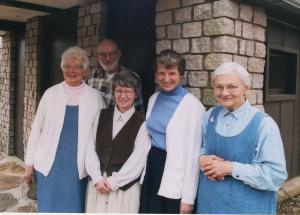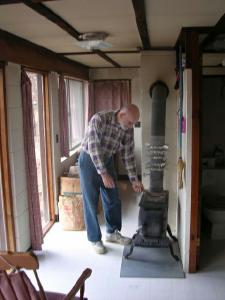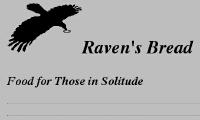 |
| From left: Sr. Mary
Bourgeois, Trappist Fr. Leon Brockman, Sr. Margaret DeVries,
Sr. Dara DeLozier and Sr. Miriam Gehringer of Nazareth
Hermitage in Missouri. -- Photos by Rich Heffern |
By RICH HEFFERN
The cause of all human trouble is our inability to sit quietly in our rooms alone, wrote the essayist Montaigne. A small number around the country who have chosen to live as hermits do just that, 24/7.
Hermits are those who choose to live alone in silence for religious reasons. They dwell on the fringes of the church, but contemporary hermits might live right in your neighborhood.
Catholic solitaries are one of two expressions of the religious life: the cenobitic -- the monk or friar -- and the eremitic. That eremetic life has a long tradition in the church, beginning with the desert saints of the second and third centuries. At one time, the Requiem Mass for the dead was said at the profession ceremony, then the hermit departed into the wilderness to live on bread, water or goat’s milk, never to be seen again.
Hermits still exist today and have adapted to new circumstances.
Karen and Paul Fredette live in a secluded location at 3,400 feet in the mountains of North Carolina. They define themselves as married hermits, and voluntarily limit their input from the outside world, doing without television or local newspapers. Dedicating their lives to solitude and silence, they call their hermitage home Still Wood. They own a computer that they use to produce a newsletter for people living the eremitic life.
The quarterly publication, available in an abbreviated version on the Web, is called Raven’s Bread. The title is derived from the experience of Elijah, the prophet in the Old Testament Book of Kings, who is nourished in his solitude by a God-sent raven.
Not all subscribers are bona fide hermits, but most, Karen Fredette believes, are living the eremitic life in some way. “Half have a background in religious life,” she said. “They live in the country and in cities. Many call New York City their hermitage home. Many are lay affiliates of a Catholic religious order. They are married and single. Some barely eke out an existence and lack health insurance. Many support themselves with simple part-time jobs ranging from bookbinding and forest management to proofreading and sewing.”
“Our society views hermits as reclusive loners or flakes,” Paul Fredette said. “There is a difference between a recluse and a hermit. The former implies fleeing from society, while the latter suggests an embrace of solitude and silence.”
It takes time to get past the loneliness to the realizations and insights that come from prolonged exposure to silence and solitude, according to Paul Fredette. “We’re not talking here about the hush between television commercials or the quiet within the car when stuck in traffic. It has to be done for a prolonged amount of time. It takes at least a couple of weeks of exposure to begin to really be nourished by silence and solitude.”
Against the current
A Poor Clare sister for many years, Karen Fredette said she found after a time that the community life no longer nourished her. “So I lived as a hermit in rural West Virginia. The background in religious life was helpful. ...
“Those who don’t have that background experiment for themselves, devising ways and means to live a life of prayer and silence,” she said. “I tell my readers to do what works best for them. They often report that it’s hard to find spiritual directors who are respectful of the eremitic way. In my own life, I remember one director telling me I was following an unnatural inclination, but I’ve learned that for me it’s a completely natural one.”
The Fredettes point out that Trappist monk and priest Thomas Merton paved the way for many, when, in the 1960s, he petitioned his abbot at Gethsemane Abbey for permission to live on the monastery grounds as a hermit. “Merton was a courageous advocate for the hermit life,” Karen Fredette said. “He wrote about his own efforts to carve out that life, but he was only the most public. Many others around the country were living a similar lifestyle at the time.”
The Fredettes said that the eremite must struggle in U.S. culture.
“Hermits swim against the current,” said Paul Fredette. “Our culture is not supportive of silence and solitude. Finding the ways and means for prayer is a problem for most Catholics. We have cell phones, call waiting, the Internet, laptops, pagers, Palm Pilots, and on and on. Technology conspires so that we can never be alone, never be quiet, never be without distractions.”
A criticism often leveled at eremites is that they opt out of the struggle for social justice. Karen Fredette defends the hermit’s spiritual engagement.
“I think we who choose a life of prayer and silence are at the hub and keep the outer spokes from flying apart. In a way that is a mystery, we hold it all together, though most of us are hidden and unknown.
“My own awareness of the world’s pain and brokenness was heightened, not lessened, by being in solitude. I was a hermit during the first Gulf War, and in my meditations, it was as if I was there where the bombs were falling. I felt the world’s pain acutely because of the lack of distraction and noise.”
“Hermits are not self-absorbed people,” Paul Fredette said. “The business of the spiritual life is always about getting yourself out of the way so that God can speak, act and dwell within you. We are aware and sensitive, though not engaged in a social-activist way but in a spiritual way.”
“One of our newsletter contributors described hermits as ‘sacristans of emptiness,’ ” Karen Fredette said. “Hermits stay in the present moment, which is eternal because it is neither past nor future, dwelling in the temple of God’s presence, letting everything flow from and back into the source. Eremites strip life to its essentials and live deliberately. They have much to say to an overactive and over-social world.”
Writing the book
Franciscan Sister of Perpetual Adoration Marlene Weisenbeck compiled a 124-page manual for the diocese of La Crosse, Wis., titled Guidebook for the Vocation to the Eremitic Life. She put the manual together after having worked with three women who petitioned the La Crosse bishop to be canonically recognized as hermits. “I was director of the office of consecrated life for the diocese from 1991 to 2002,” she told NCR. “The manual is a compilation of the sources I consulted and used in working with the women. It provides a practical way to pursue the vocation of eremitic life.”
The manual has been widely distributed throughout the United States both to individuals seeking information and through the National Conference of Vicars for Religious. “The vicars for religious are the ones who most often are involved in giving direction to these persons,” Weisenbeck said.
The manual includes a thorough commentary on Canon 603, guidelines for setting up a rule for the hermit life, request forms for canonical status, recommendations for stewardship of financial resources, an extensive bibliography, and even a blessing ritual for hermitages.
Weisenbeck said that currently there are five canonical hermits in the La Crosse diocese.
“People seem to pursue this option in mid- or later life,” she said. “They find themselves on a significant spiritual journey after other aspects of their life have been completed. They seek to have the approbation of the church for their life of solitude, prayer and penance. They’re also looking for direction and guidance.”
 |
| Trappist Fr. Leon Brockman checks a wood stove in Nazareth Hermitage. |
Nazareth Hermitage sits on the top of a long ridge overlooking deep, forested valleys in the Ozark Mountains of southern Missouri. Srs. Mary Bourgeois, Dara DeLozier, Margaret DeVries and Miriam Gehringer, and their chaplain, Trappist Fr. Leon Brockman, live there full-time.
The hermitage was established in 1976 with the permission of the local bishop. When the new Code of Canon Law was promulgated in 1983, the two founding sisters made their vows according to Canon 603.
Each lives in his or her own hermitage, a small cement-block house dug into the side of the ridge. Windows look out over the trees to the distant vistas of the oak-pine forest.
In the winter, chickadees and titmice twitter in the tree branches and red squirrels rummage through the fallen leaves. When spring blooms in these hills, dogwood and redbud decorate the slopes below. In the summer the lush foliage shades the hermitages.
Each hermitage has a wood stove for winter heat, a small electric hot plate for cooking, and a refrigerator. There is a shower and a small prayer room where the Eucharist is reserved. The furnishings are simple -- a small bed, a desk and a chair.
Nazareth Hermitage is modeled on the ancient “laura” concept. The name originates from fourth-century Palestine and describes a group of hermitages located around a central chapel.
Every day they meet in the community chapel for Mass. Once a week they gather for a common vegetarian meal, which they take turns cooking. They make their own bread and yogurt from scratch.
Each hermit rises early, at 3 a.m. Each prays the liturgy of the hours alone. They told NCR that there’s a flexible structure to their day, allowing each hermit to adapt to whatever seems best suited to her needs, while incorporating various practices common to all. One practice, for example, is agreeing to work only three hours a day in the winter, and four in the summer.
Brockman, as spiritual father of the laura, meets with each hermit once a week for spiritual direction.
The laura supports itself by making and selling liturgical incense. Ingredients are ground, mixed and packaged in the winter, then orders are filled throughout the year.
Each member has a hermitage industry. One makes rosaries, another liturgical stoles, another paints icons, another does proofreading for Cistercian Publications. Brockman looks after general maintenance, works the garden in the summer and splits firewood in the winter. He maintains the old van they use for their infrequent supply trips to town.
The laura includes a large garden and a greenhouse for growing winter salad makings. They raise all their own vegetables, storing the summer’s bounty in a freezer for later use.
Staples are purchased in bulk quantities from the health food store in the nearest small town, Ava, Mo., 20 miles away.
“The church reflects every aspect of Jesus’ life,” DeVries told NCR. “He loved to go out into the desert and pray alone. It’s our job to reflect that side to the rest of Christ’s mystical body.” DeVries lived for 22 years as a cloistered Dominican before coming to this Ozark laura.
“For me it was an evolution in religious life, a blossoming out. I felt the call as a kind of nagging, a wish for more time alone for prayer. As soon as I made the decision for this life, doors began to open for me.”
Gehringer identified solitude as the draw. “It’s what we come here for,” she said. A Servant of Mary sister, Gehringer taught for 33 years. “Our spiritual nurturing comes primarily from within. It’s a satisfying life, but it can also be a struggle. Prayer gets dry. It can be a real desert experience. Faith can be stark when there’s no outward ministry, no roles to fulfill.”
“It’s more than just being alone and doing your own thing,” said Bourgeois, a former Poor Clare Sister for 31 years. “There’s so little outward stimuli, it forces you to face your own brokenness. We tend to fashion God in our own image, but the prolonged aloneness shatters those idols.”
“I had lived for 13 years as a Marist missionary and 20 as a Poor Clare sister,” said DeLozier. “Most of that time I saw my spiritual life as an ascent. After some time here, I realized I had been going in the wrong direction. The right direction is down, into the depths of emptiness and humility. It’s a ‘kerplunk’ experience. You need to lose yourself, get yourself out of the way. And the daily life has a way of pulling and stretching you.”
“Solitude purifies the senses,” said Gehringer. “You eat a piece of toast, not just wolfing it down, but mindfully savoring every bite.
“What’s more, I have windows on three sides of my hermitage and every day I watch the sun go down, then come up the next morning, and those evenings when the moon rises I look for it. I roam the woods in the springtime noticing the little woodland wildflowers that spring up everywhere. Somebody needs to be here witnessing God’s magnificent work. That’s part of our job description as hermits.”
“Winter is my favorite season here,” Bourgeois said. “The short days and long nights force me to go within. I can’t help but notice, too, the stark beauty of the forest. The intricate lacework of the bare tree branches against the grey winter skies speaks to me of God.”
Brockman said that solitude is a rich resource for anyone living a Christian life, that self-knowledge requires it. “To be able to see oneself accurately and completely, without distraction, is a great blessing. You are free to go where the truth takes you.”
DeLozier said their occasional town trips are experienced as “an insertion of our gift of solitude into the fragmented energy we encounter. On returning to our hermitage we pray to the Lord with added fervor, to bring his peace into this hectic atmosphere.”
Wilderness of the human spirit
The contrast between the eremite and a multitasking urbanite is stark. The 21st-century hermit must relate his or her contemplative efforts to a world interested mainly in action and results. Catholic solitaries agree, though, that they have something to say to the rest of us.
“If there were more silence and solitude in our frenzied world,” Paul Fredette asked, “would there perhaps be less violence, rage, loneliness and despair? Would we be so tormented by impatience, anxiety, rash judgment, anger and depression?”
Thomas Merton observed that the real wilderness of the hermit is the wilderness of the human spirit, and what the hermit seeks in that wilderness is “not himself, not human company and consolation, but God.”
Judith Rucker, a Texas hermit, wrote: “When I become empty, when I am undone, God pours his love through me like water through a sieve.”
Evenings now in the valleys below Still Wood and Nazareth Hermitage, owls call to each other in ghostly voices. The night wind stirs, whispers through bare branches, shuffles through fallen leaves, then lies calm again.
Hermits are there to witness the night, to cherish its dark silence, and to pray for us.
Rich Heffern is former editor of Praying magazine and author of Daybreak Within: Living in a Sacred World (Forest of Peace). His e-mail address is heffern@diocesekcsj.org.
| Life of solitude found in varied settings Paul Fredette said that he and his wife, Karen, are surprised by the variety of life circumstances they see in the readership of Raven’s Bread, their quarterly newsletter for people living the eremitic life. “Some are living on Social Security. Others live the hermit life while caring for aging parents. Married partners in the suburbs make an arrangement with wife or husband and kids. They fashion a contemplative life out of the circumstances of life as it comes to them.”
According to a 2001 survey of their readership, a quarter of respondents began eremitic life in their 50s; a smaller percentage started in their 40s. Most considered their health to be good or excellent, and cited this as a positive factor in choosing solitude. Though many lived in rural settings, the majority described their environs as urban or suburban, with a few in poor, inner-city areas. Others lived in religious communities, and only two of the 122 respondents described their setting as wilderness. Most subscribers are Catholic, with a few Lutherans and Episcopalians, she said. “The Protestant tradition has little history of or sympathy with hermits.”
Some of the Catholics have sought recognition under Canon 603 of the Code of Canon Law, which recognizes “hermit” or “anchoritic” status in the church, Karen Fredette said. Twenty percent of the Catholic survey respondents had gained canonical status for their eremitic life. They “are publicly recognized as professed hermits, either linked to a diocese or a religious order,” she said. Most respondents followed traditional structures of prayer and liturgy, and reported dealings with religious authorities as problematic. Twenty-two of the 122 respondents were married. The Fredettes conclude that many are being called to a life of solitude and are responding in whatever fashion is available to them. “New lifestyles are emerging without significant support from leadership other than that of the Spirit speaking in individual hearts and souls,” Karen Fredette said. “There are as many ways of living the hermit life as there are people doing it.” -- Rich Heffern |
National Catholic Reporter, February 27, 2004
 “We currently have 750 subscriptions worldwide,” Karen
Fredette told NCR. “Of those, 125 are foreign. We mail to every
state in the union including Alaska and Hawaii. We have subscribers in Northern
Ireland, Germany, Belgium, Scotland, the Philippines and many other
countries.”
“We currently have 750 subscriptions worldwide,” Karen
Fredette told NCR. “Of those, 125 are foreign. We mail to every
state in the union including Alaska and Hawaii. We have subscribers in Northern
Ireland, Germany, Belgium, Scotland, the Philippines and many other
countries.”